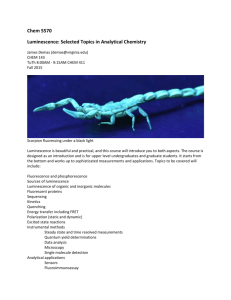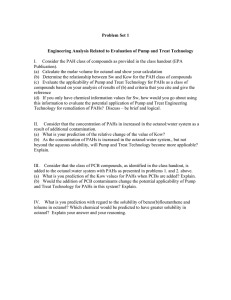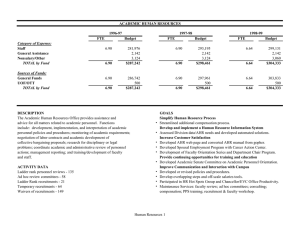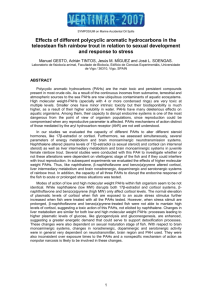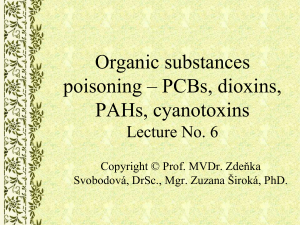Document 12070815
advertisement
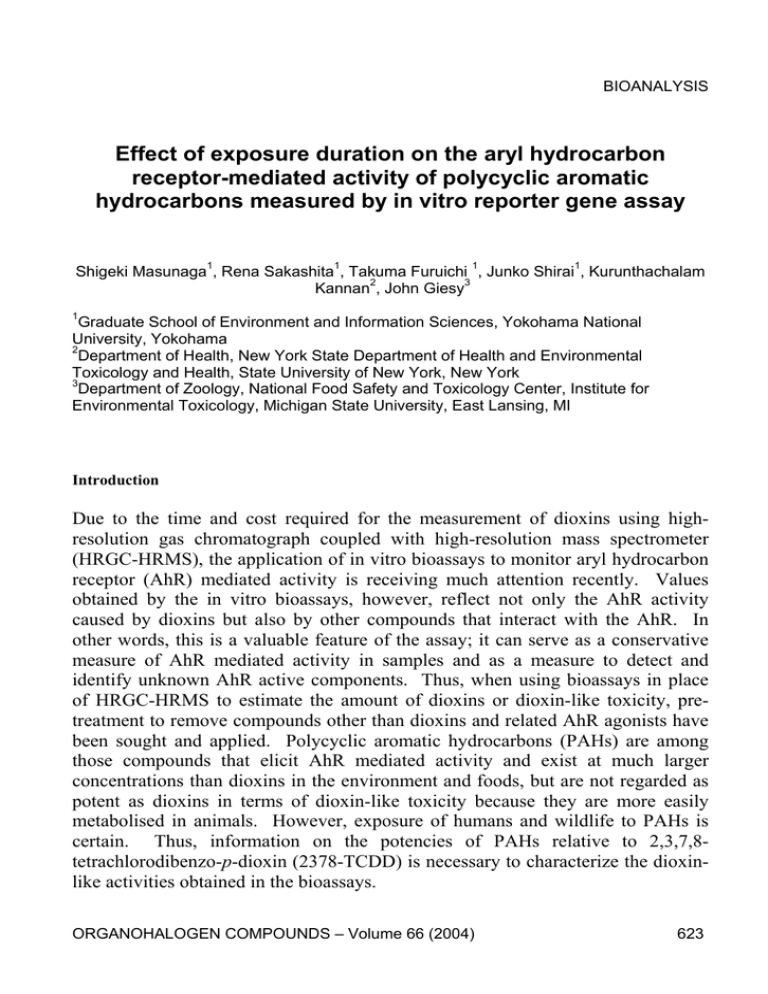
BIOANALYSIS Effect of exposure duration on the aryl hydrocarbon receptor-mediated activity of polycyclic aromatic hydrocarbons measured by in vitro reporter gene assay Shigeki Masunaga1, Rena Sakashita1, Takuma Furuichi 1, Junko Shirai1, Kurunthachalam Kannan2, John Giesy3 1 Graduate School of Environment and Information Sciences, Yokohama National University, Yokohama 2 Department of Health, New York State Department of Health and Environmental Toxicology and Health, State University of New York, New York 3 Department of Zoology, National Food Safety and Toxicology Center, Institute for Environmental Toxicology, Michigan State University, East Lansing, MI Introduction Due to the time and cost required for the measurement of dioxins using highresolution gas chromatograph coupled with high-resolution mass spectrometer (HRGC-HRMS), the application of in vitro bioassays to monitor aryl hydrocarbon receptor (AhR) mediated activity is receiving much attention recently. Values obtained by the in vitro bioassays, however, reflect not only the AhR activity caused by dioxins but also by other compounds that interact with the AhR. In other words, this is a valuable feature of the assay; it can serve as a conservative measure of AhR mediated activity in samples and as a measure to detect and identify unknown AhR active components. Thus, when using bioassays in place of HRGC-HRMS to estimate the amount of dioxins or dioxin-like toxicity, pretreatment to remove compounds other than dioxins and related AhR agonists have been sought and applied. Polycyclic aromatic hydrocarbons (PAHs) are among those compounds that elicit AhR mediated activity and exist at much larger concentrations than dioxins in the environment and foods, but are not regarded as potent as dioxins in terms of dioxin-like toxicity because they are more easily metabolised in animals. However, exposure of humans and wildlife to PAHs is certain. Thus, information on the potencies of PAHs relative to 2,3,7,8tetrachlorodibenzo-p-dioxin (2378-TCDD) is necessary to characterize the dioxinlike activities obtained in the bioassays. ORGANOHALOGEN COMPOUNDS – Volume 66 (2004) 623 BIOANALYSIS In this study, AhR mediated activities of nineteen PAHs were examined by chemically-activated luciferase gene expression (CALUX) assay using H4IIEluciferase cells at various exposure durations. Methods and Materials Chemicals: Sixteen PAHs designated as priority pollutants by the USEPA and three nitro-PAHs were selected as the target chemicals for this study (Table 1). The ninetenn PAHs and 2378-TCDD standards were purchased from AccuStandard, Inc. (New Haven, CT). The standards were dissolved in methanol and used. Cell line for in vitro assay: Chemically-activated luciferase expression assay was performed using H4IIE-luciferase cell line. The H4IIE-luciferase cells are rat liver hepatoma cells stably transfected with a luciferase reporter gene under the control of dioxin response elements (DREs) 1. When this cell line is exposed to chemicals that bind to AhR, the cells produce luciferase, an enzyme that is responsible for luminescence in fireflies. With the addition of luciferin to the cell culture, rate of luminescence is measured to quantify the presence of AhR agonists or dioxin-like activity. The cell line used for this study was developed and maintained at John Giesy’s laboratory at Michigan State University. In vitro assay procedure: H4IIE-luciferase cells were plated into the 60 interior wells of 96-well microplate (Packard 96-Well View PlatesTM). Two hundred fifty µl of culture media was dispensed into each well at a density of approximately 75,000 cells/ml. The 36 exterior wells of each plate were filled with 250 µl of media. Cells were incubated overnight in a CO2 incubator at 37°C prior to dosing. Test wells were dosed with 2.5 µl of standard solution in triplicate. Solvent control wells were dosed with the similar solvent used for standard solution (methanol) except blank wells, which received no dose. For standard calibration, six different concentrations of 2378-TCDD solutions were dosed in triplicate. Luminescence was measured by microplate luminometer (LumiCount, Packard) at 6, 24, 48, and 72 hours of exposure to PAHs. Instrumental analysis of PAH concentrations in wells: Changes of PAH concentrations in the microplate wells during the incubation were monitored by high performance liquid chromatograph (Hewlett Packard HP1100) coupled with a diode array detector (Hewlett Packard G1315A). A reverse phase gradient system ORGANOHALOGEN COMPOUNDS – Volume 66 (2004) 624 BIOANALYSIS (column: Wakosil-PAHs (4.6 mmΦ x 250 mm, particle size = 5 µm); mobile phase: CH3CN/H2O = 50/50, 0.6 mL/min) was used with 100 µL of sample injection. Table 1 Polycyclic aromatic hydrocarbons tested in this study Chemicals Abbreviation No. of rings 2 3 3 3 3 3 3 4 4 4 4 4 5 5 5 Molecular formula MW Carcinogenicity by IARC* Naphthalene Nap C10H8 128 Acenaphthylene Acl C12H8 152 Acenaphthene Ace C12H10 154 Fluoren Flu C13H10 166 178 Phenanthrene Phe C14H10 Anthracene Ant C14H10 178 3 Fluoranthene Fla C16H10 202 Pyrene Pyr C16H10 202 Benz[a]anthracene BaA C18H12 228 2A 228 Chrysene Chr C18H12 Benzo[b]fluoranthene BbF C20H12 252 2B Benzo[k]fluoranthene BkF C20H12 252 2B Benzo[a]pyrene BaP C20H12 252 2A Dibenz[a,h]anthracene DBahA C22H14 278 2A Indeno[1,2,3IDP C22H13 277 2B cd]pyrene 276 3 Benzo[g,h,i]perylene BghiP 5 C22H12 1-Nitropyrene 1-NP 4 C16H9NO2 247 2B 1,6-Dintropyrene 1,6-DNP 4 C16H8N2O4 292 2B 3-Nitrofluoranthene 3-NF 3 C16H9NO2 247 3 * IARC: International Agency for Research on Cancer. 2A: Probable human carcinogen; 2B: Possible human carcinogen; 3: Not classifiable. Results and Discussion Effect of exposure duration of 2378-TCDD on the luminescence in vitro: First, changes in luminescence with time following exposure to 2378-TCDD were ORGANOHALOGEN COMPOUNDS – Volume 66 (2004) 625 BIOANALYSIS examined in vitro. The luminescence was corrected by subtracting that in control wells for respective exposure time and the results are shown in Figure 1. For low dose exposure (0.000032 and 0.00016 µg/mL), no change in relative luminescence was observed, while for higher doses (≥0.0008 µg/mL) the maximum luminescence was found at 72 h of exposure. Since 2378-TCDD is used as a standard to report AhR mediated toxicity in the bioassay, this result suggests that different exposure times can alter the absolute luminescence even for the standard compound, 2378-TCDD. The relative change, however, was much less when the results were expressed as a percentage of maximum luminescence (%TCDD-max) for each exposure time (see Figure 2). 12000 Relative Light Unit 10000 8000 1 ng /m L 0 .2 ng /mL 6000 0 .0 4 ng /m L 0 .0 0 8 ng /m L 4000 0 .0 0 1 6 1 ng /m L 0 .0 0 0 3 2 ng /m L 2000 0 -2000 0 12 24 36 48 60 72 84 96 E x p o su re Ti m e (h o u rs) Figure 1 Effect of 2378-TCDD exposure duration on the luminescence of H4IIE-luciferase cells in vitro at various dose levels Dose levels are expressed as the concentration in microplate wells. Effect of exposure duration of PAHs on relative potency: Nineteen PAHs were dosed to H4IIE-Luciferase cells and luminescence was monitored at 6, 12, 24, 48 and 72 h of exposure. For all of the PAHs with two to three aromatic rings (Nap, Acl, Ace, Flu, Phe, Ant and Fla) and Pyr, the maximum luminescence did not reach 10% of the maximum luminescence observed for 2378-TCDD (10%TCDDmax) at respective exposure times, indicating that these PAHs did not have significant AhR mediated activity. For the rest of the PAHs, whose luminescence exceeded 10%TCDD-max, their luminescence reached maximum in 6 h of exposure and decreased thereafter. The dose-response curves expressed in terms ORGANOHALOGEN COMPOUNDS – Volume 66 (2004) 626 BIOANALYSIS of %TCDD-max for BbF are shown in Figure 2, as an example. The curves for BbF shifted to right with an increase in the exposure duration while those for 2378-TCDD did not vary much. In the case of BbF, its AhR mediated activity was as great as that of 2378-TCDD at 6 h of exposure, but decreased by three orders of magnitude at 24 h of exposure. The decrease of activity by 2- to 3- orders of magnitude between 6 and 24 h of exposure was commonly observed for the PAHs with significant AhR mediated activity. These results indicate that PAHs could have as high AhR mediated activity as 2378-TCDD in short exposure studies, but their activity would change with time. The relative potencies (REPs) of the PAHs examined in this study were calculated based on the concentrations corresponding to 50%TCDD-max (EC50) for PAH and 2378-TCDD using the following equation. REP = EC50 (2378-TCDD) / EC50 (PAH) The results are shown in Table 2. The relative potencies for BaA, Chr, BbF, BkF, BaP, DBahA, and IDP decreased by 2- to 4- orders of magnitude between 6 and 48 h of exposure. Attention should be paid to the fact, however, that luminescence elicited by 2378-TCDD increased by about 4 fold during the same period. Relative potencies reported in the literature for the same assay are also shown in Table 2. The results are in good agreement with those reported earlier. 100 6 hr 24 hr Chemical and exposure time 80 %TCDD-max 48 hr 60 72 hr TCDD 6hr TCDD 24hr TCDD 48hr TCDD 72hr 40 BbF 6hr 20 BbF 24hr BbF 48hr 0 -10 -13 BbF 72hr -11 -9 -7 -5 log (exposure concentration in mol/L in well) Figure 2 Dose response curves of BbF and 2378-TCDD at different exposure durations in H4IIE-luc assay ORGANOHALOGEN COMPOUNDS – Volume 66 (2004) 627 BIOANALYSIS Table 2 Exposure time dependence of relative potency for selected PAHs This study From literature 2, 3 No. of Chemicals Exposure time Exposure time Rings 6 hr 24 hr 48 hr 72 hr 6 hr 2 24 hr 2 72 hr 3 23781 1 1 1 1 1 1 2 TCDD 7.18E-03 1.23E-05 wr wr 7.64E-07 7.04E-06 1.90E-06 BaA 4 1.44E-02 4.68E-04 1.84E-06 wr 1.41E-02 1.01E-04 2.30 E-06 Chr 4 2.00E-01 1.21E-04 2.27E-05 1.44E-05 4.90E-02 3.35E-05 5.10 E-06 BbF 5 7.24E-02 4.17E-04 7.57E-05 5.32E-05 2.80E-01 1.64E-03 1.40 E-04 BkF 5 3.52E-03 1.62E-05 3.47E-06 wr 1.11E-02 9.01E-05 1.60 E-06 BaP 5 2.52E-02 1.59E-04 3.79E-05 1.11E-04 6.00E-02 1.17E-03 4.60 E-06 DBahA 5 7.95E-03 1.15E-04 3.51E-05 4.82E-05 8.60E-01 2.96E-04 1.50 E-05 IDP 5 wr nr nr nr 2.27E-05 nr nr BghiP 5 3.16E-05 wr wr nr 1-NP 4 wr wr nr nr 1,6-DNP 4 2.47E-04 wr wr nr 3-NF 3 wr: week response (less than 50%TCDD-max); nr: no response; -: not reported. Metabolism of PAHs in cell culture: In order to test the reason for the rapid decrease in the AhR activity with exposure duration, fates of BaA, BbF, BaP and IDP in microplate wells were monitored. The experiments were conducted at two concentration levels (around 0.2 and 2 µg/mL in well). The spiked compounds decreased with incubation time in the cell culture wells, while those in control wells did not decrease. The half-lives for BaA, BbF, BaP, and IDP in cell culture wells were in the range of 6 to 11, 10 to 14, 11 to 12, and 14 to 21 h, respectively. IDP had the longest half-live and its decrease of REP was slower than the other PAHs, indicating that metabolism of PAHs was the cause for loss of activity. As 2378-TCDD was reported to be resistant to metabolism in rat’s CYP1A1 4, it is reasonable that 2378-TCDD did not lose its activity during the exposure. Conclusions AhR mediated activities for some PAHs were measured by chemically-activated luciferase gene expression assay using H4IIE-luciferase cells. The highest relative potency against 2378-TCDD (0.2) was observed for BbF at 6 h of exposure. ORGANOHALOGEN COMPOUNDS – Volume 66 (2004) 628 BIOANALYSIS Relative potencies for all the PAHs tested decreased rapidly by 2- to 4- orders of magnitude during 6 and 48 h of exposure. Thus, longer exposure time will decrease the contribution of PAHs to the activity measured in the assay. This indicates that incomplete removal of PAHs in the pre-treatment procedure may be acceptable for measuring dioxin-like activity when longer exposure time is used in H4IIE-luciferase assay. Acknowledgements This work was supported by The 21st Century COE Program "Bio-Eco Environmental Risk Management" and Grant-in-Aid for the Creation of Innovations through Business-Academic-Public Sector Cooperation (No. 12323), Ministry of Education, Culture, Sports, Science and Technology of Japan. References 1. Sanderson, T., Aarts, J. M. M. J. G., Brouwer, A., Froese, K. L., Denison, M. S., Giesy, J. P. (1996) Toxicology & Applied Pharmacology 137, 316-325. 2. Machala, M., Vondracek, J., Blaha, L., Ciganek, M., Neca, J. (2001) Mutation Research 497, 49-62. 3. Villeneuve, D. L., Khim, J. S., Kannan, K., Giesy, J. P. (2002) Environmental Toxicology 17, 128-137. 4. Shinkyo, R. Sakai, T., Ohta, M., Inoue, K. (2003) Arch. Biochem. Biophysics 409, 180-187. ORGANOHALOGEN COMPOUNDS – Volume 66 (2004) 629
